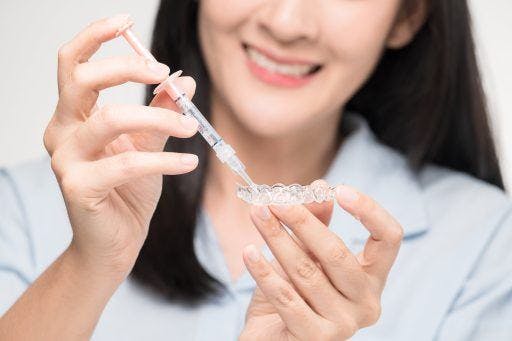A gleaming smile is not only a sign of good oral health, but it’s also a surefire way to make an outstanding first impression. While these split-second opinions often do not last, an experimental study published in the Journal of Dentistry reveals that those with whiter teeth are perceived as friendlier, more intelligent, and more confident. No wonder people invest so much to whiten teeth, with either at-home kits or dental treatments.
Whitening teeth becomes trickier when you wear a teeth-straightening apparatus. For instance, abrasive whitening chemicals can damage the orthodontic aligner trays and cause tooth sensitivity.
Does this mean you must make peace with stained teeth until your realignment treatment is complete? For those who want to whiten teeth despite wearing aligners, keep reading for the dos and don’ts.
Teeth Whitening While Wearing Clear Aligners

The short answer is: you can whiten your teeth while wearing clear aligners.
Orthodontics Australia explains that any sensitivity or soreness during treatment stems from the slight pressure of the aligners and not from enamel erosion. The latter is a crucial concern since whitening, when performed incorrectly, can damage your teeth. So, as long as you have no pre-existing dental issues, you can use teeth-whitening products and aligners together. However, you should still consult your dentist or orthodontist for the safest solution considering your dental history and lifestyle.
Another factor that might hamper your determination to whiten your teeth is the material of your aligners. Whitening agents may destroy or discolour aligners made with lower-quality plastic. However, more premium ones are durable enough to endure these issues. For example, ClearCorrect features a patented ClearQuartz tri-layer stain-resistant material. The outer shells are tough, yet the inner part is elastic to maximise comfort. You can have straight and white teeth with no problem.
How to Whiten Teeth with Aligners
The average teeth alignment process is 12 months. Is waiting a year (or more) to whiten your teeth unfavourable for you? You can try these treatment options, which are generally safe and effective for clear-aligner users.
1. Whitening gel

You can get whitening gels from grocers or your neighbourhood dental clinics. Most gels contain hydrogen or carbamide peroxide, the same chemicals dentists use for laser teeth-whitening. The difference is the concentration. At-home kits have a lower concentration of peroxide, which makes them failproof for beginners but still effective.
Whitening gel packages feature the gel, plus syringes and orthodontic trays. Swap the trays with your aligners. A 2021 study finds that using clear aligners as whitening trays improves tooth shade. Use the syringe to apply a tiny amount of gel inside the aligners. Put them on your teeth and swab the excess gel that oozes out of the trays with a cotton bud. After 45 minutes, remove your aligners and clean them thoroughly. Brush your teeth as well and pop the aligners back in. You’ll see results in about one to two weeks.
2. Whitening toothpaste
If you naturally have white teeth, whitening toothpaste can polish your enamel with minimum side effects. Some ingredients are better than others. For example, hydrogen peroxide-based toothpaste works best at removing stains, but it can damage the surfaces of your teeth if used long-term. On the flip side, the Dentistry Journal claims toothpaste containing hydrated silica is less abrasive and can whiten teeth effectively.
Your pick in toothpaste will be for naught if you don’t practise a proper teeth-cleaning habit. Brush your teeth at least twice daily, after waking up and before sleeping. Remember to floss, rinse your mouth, and clean your tongue for fresh breath and a beaming smile.
3. Whitening pen
For more instant results, try a whitening pen. It’s a portable version of whitening gel since it contains the same peroxide chemicals. When you “paint” over your teeth with the pen, it leaves a film of bleaching agent that becomes solid after a few minutes. This new layer makes your teeth look visibly brighter right after use.
The benefit of using this magic pen is you can whiten your teeth at any time – before a presentation, a romantic date, or a photo shoot. However, consider two downsides. First, the whitening effect is not long-lasting, as the film will dissolve when you brush your teeth. Most importantly, don’t overuse a whitening pen because the ingredients can irritate your gums and thin out your enamel.
Tips to Keep Your Teeth Stain-Free
What you eat can determine the shade of your teeth. Coffee, tea, and vino cause your teeth to turn yellow. If you can’t part with these beverages, use a straw to reduce the contact between the liquid and your teeth.
Aside from your diet, the cleanliness of your aligners is also necessary in maintaining your pearly whites. Any food particles stuck on your teeth and trapped by the aligners can stain your teeth. So, brush your teeth after eating and before putting your aligners in. Rinse the trays after every use with water to avoid dried saliva from building up.
Again, let your orthodontist know about your plan to whiten your teeth at home. They may give you product recommendations and even offer a complimentary teeth-whitening service. If you use ClearCorrect, your dentist or orthodontist can customise your treatment and wear plan to your preference with the extensive guide from ClearPilot. Take care of your teeth the best you can, and your future self will thank you.
References:
All you need to know about sensitive teeth and braces. Orthodontics Australia.
Khashashneh, M., Ratnayake, J., Choi, J. J. E., Mei, L., Lyons, K., & Brunton, P. A. (2022b). The Effectiveness of Dental Bleaching during Orthodontic Treatment with Clear Aligners: A Systematic Review. Applied Sciences, 12(21), 11274.
Newton, J. T., Subramanian, S., Westland, S., Gupta, A., Luo, W., & Joiner, A. (2021). The impact of tooth colour on the perceptions of age and social judgements. Journal of Dentistry, 112, 103771.
Suriyasangpetch, S., Sivavong, P., Niyatiwatchanchai, B., Osathanon, T., Gorwong, P., Pianmee, C., & Nantanapiboon, D. (2022). Effect of Whitening Toothpaste on Surface Roughness and Colour Alteration of Artificially Extrinsic Stained Human Enamel: In Vitro Study. Dentistry Journal, 10(10), 191.
Torres, V. M., Lima, M. J. P., Valdrighi, H. C., De Jesus Campos, E., & Santamaria, M. P. (2020). Whitening Dentifrices Effect on Enamel with Orthodontic Braces after Simulated Brushing. European Journal of Dentistry, 14(01), 013–018.



